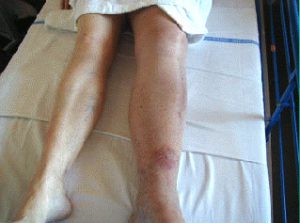Venous Thrombosis
- These clots form in veins deep inside the leg. The veins involved cannot be seen.
- These most commonly form in the leg veins but can occur in other parts of the body such as the arms or intestines.

A deep vein thrombosis can present with the following symptoms.
- Pain – this can be anywhere in the leg but is commonly felt in the calf.
- Swelling – often most obvious around the ankle, but can involve the whole leg.
- Redness – a slight dusky discolouration of the leg is common.
- Warmth – the leg feels warm to touch.
These are the most common symptoms of a deep vein thrombosis but they are not all present in all cases.
Treatment
Deep vein thrombosis and pulmonary embolus are treated with anticoagulants. These drugs do not dissolve the clot but work by slowing the normal clotting mechanism. This allows the body to naturally break down the blood clot. In New Zealand DVTs are treated with either warfarin or dabigatran (Pradaxa). In both cases a short course of heparin is given first. If the clot is associated with underlying cancer the patient may remain on LMW heparin for the whole treatment period.
For treatment details see Anticoagulant treatment
